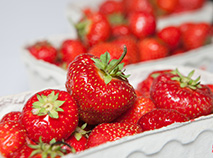New type of packaging to reduce food waste
In Denmark we throw away more than 700,000 tons of food every year. Together with colleagues and companies scientists from Aarhus University are in the process of developing and testing new types of packaging solutions to ensure that fresh fruit and vegetables do not rot quite as quickly.

Fresh fruit and vegetables are alive – even after harvest. And this is the exact reason why significant amounts of these products are thrown away; the products are delicate and the packaging does not always create the perfect conditions.
In a new project Aarhus University – in cooperation with the Danish Technological Institute and a series of companies – currently try to develop new types of packaging solutions that may help reduce rot of fresh fruit and vegetables in the supply chain. The project received funding to the amount of approx. 3.5 million DKK from the industrial support scheme Green Development and Demonstration Programme (GUDP) within the framework of the Ministry of Environment and Food of Denmark.
– Quality at harvest, storage temperature, and humidity are decisive factors for shelf life – and these should be considered when selecting the appropriate packaging materials. If packaging is too tight the humidity caught inside will result in growth of microorganisms which, in turn, will cause the fresh produce to rot. It is thus of extreme importance to find solutions that prevent and reduce the problems with high humidity, explains Associate Professor Merete Edelenbos, who represents the Department of Food Science at Aarhus University in this project.
Strawberries – with or without wrapping film
The first examinations are already finished. Last summer scientists from Aarhus University’s department in Årslev accomplished several preliminary experiments with strawberries grown outdoors and examined e.g. the differences in berry weight and quality according to whether they were packaged in trays or in trays and wrapped with film.
- We examined the importance of raw material quality at the time of harvest – i.e. whether the berries were dry or wet at packaging. The project participants will also examine if the incorporation of natural plant extracts, sugar and salts into the packaging solution may help reduce microbial growth, says Merete Edelenbos.
Black spots on root vegetables
Another group of foods requiring attention is carrots which often get black surface spots in autumn. The spots are rather harmless but still cause problems. – The fungi give rise to significant household waste because the vegetables have these unappetizing grey and black spots when stored in plastic materials for weeks in the refrigerator and consumers do not know what to do about them, says Merete Edelenbos. Together with her colleagues she will try to identify new solutions to reduce the occurrence of black rot without giving rise to other quality problems. In addition, they will have a closer look on how to prevent white blush of fresh-cut carrots after packaging.
The project group has high hopes regarding the project’s impact. Active packaging is supposed to ensure improved quality and longer shelf life of fresh fruit and vegetables when consumers buy them. It is also expected to result in savings to the amount of 244 million DKK a year due to reduced food waste. Finally, the project has the potential of reducing climate impact with as much as 14,500 tons CO2 per year.
Further information
Associate Professor Merete Edelenbos
Department of Food Science, Aarhus University
Science Team Food Quality Perception & Society
Tel.: +45 87158334
Mobile: +45 29450133
E-mail: merete.edelenbos@food.au.dk
The packaging project is accomplished in cooperation between the Danish Technological Institute, Aarhus University, and the companies Hunsballe Grønt, Limfjord Danske Rodfrugter, DLG Lammefjords Grønt A/S, Schur Pack Denmark a/s, NNZ Scandinavia ApS, Scanstore Packaging A/S, and Dansk Supermarked A/S. The projected will be finished in the end of 2018.
